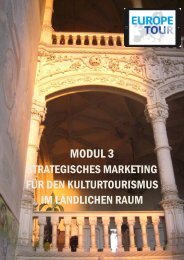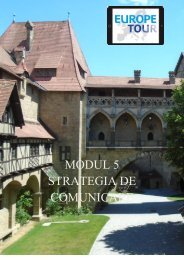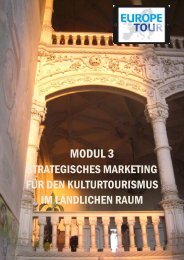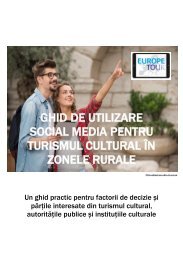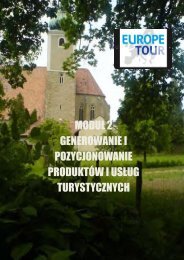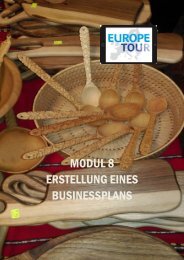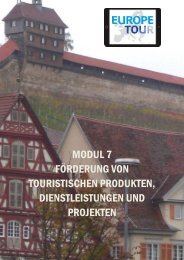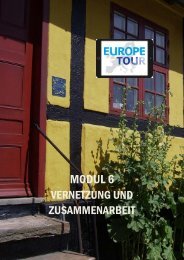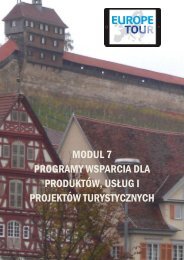Module_3_Marketing_Strategy
You also want an ePaper? Increase the reach of your titles
YUMPU automatically turns print PDFs into web optimized ePapers that Google loves.
CULTURAL TOURISM TRAINING COURSE<br />
MODULE 3 - STRATEGIC MARKETING IN CULTURAL TOURISM<br />
Competitive strategies<br />
Here you look at your own market position vis-à-vis your competitors. Depending on the situation, you<br />
might decide for more aggressive or more cooperative strategies, depending on whether you plan to<br />
enlarge your market share or to defend it.<br />
In aggressive strategies you will use your own strengths. This may concern<br />
• Quality leadership: you use your your success position or USP as an asset.<br />
• Cost leadership: if you have cost advantages over your competitor, then you could employ<br />
aggressive pricing strategies, but this not a qualified option for cultural tourism.<br />
You can also opt for a niche strategy through specialisation where you try to ob-tain price advantages.<br />
Me too strategy: This strategy lies between aggressive and cooperative strategies and applies in<br />
developed markets that offer enough “space” for more providers.<br />
In many cases, providers prefer a cooperative strategy: Several – mostly equally large – providers try<br />
together to build the market. They enter into cooperation, networks and strategic alliances and achieve<br />
cost advantages in joint purchase and advertising. For cultural tourism, this is the most beneficial<br />
strategy.<br />
Customer strategies<br />
These strategies deal with market segmentation according to target groups. Seg-mentation criteria can<br />
be done along various criteria, e.g. along<br />
• socio-demographic segmentation<br />
• segmentation according to travel styles<br />
• psychographic segmentation<br />
Another possibility could be to segment your market according to the principal reason for travel:<br />
• recreational and leisure travel<br />
• visiting friends and relatives<br />
• business travel<br />
• adventure, cultural heritage, and experiential travel and, of course,<br />
• cultural interests<br />
These groups have implications in terms of length of stay, intensity of travel, ac-commodation<br />
preference, predisposition to spend money, and general choice of activities.<br />
Markets can then be segmented by additional tourist-specific methods such as demographics,<br />
psychographics, and spending patterns or behaviors. Look at the visitor survey on the following pages!<br />
The methods for segmentation are often combined to create richer and nuanced visitor profiles that<br />
permit even more targeted marketing and product development. In other words, the more marketers<br />
know about the desired experience, the more they should refine their products and advertising to meet<br />
a visitor’s desires, needs, and expectations.<br />
27




